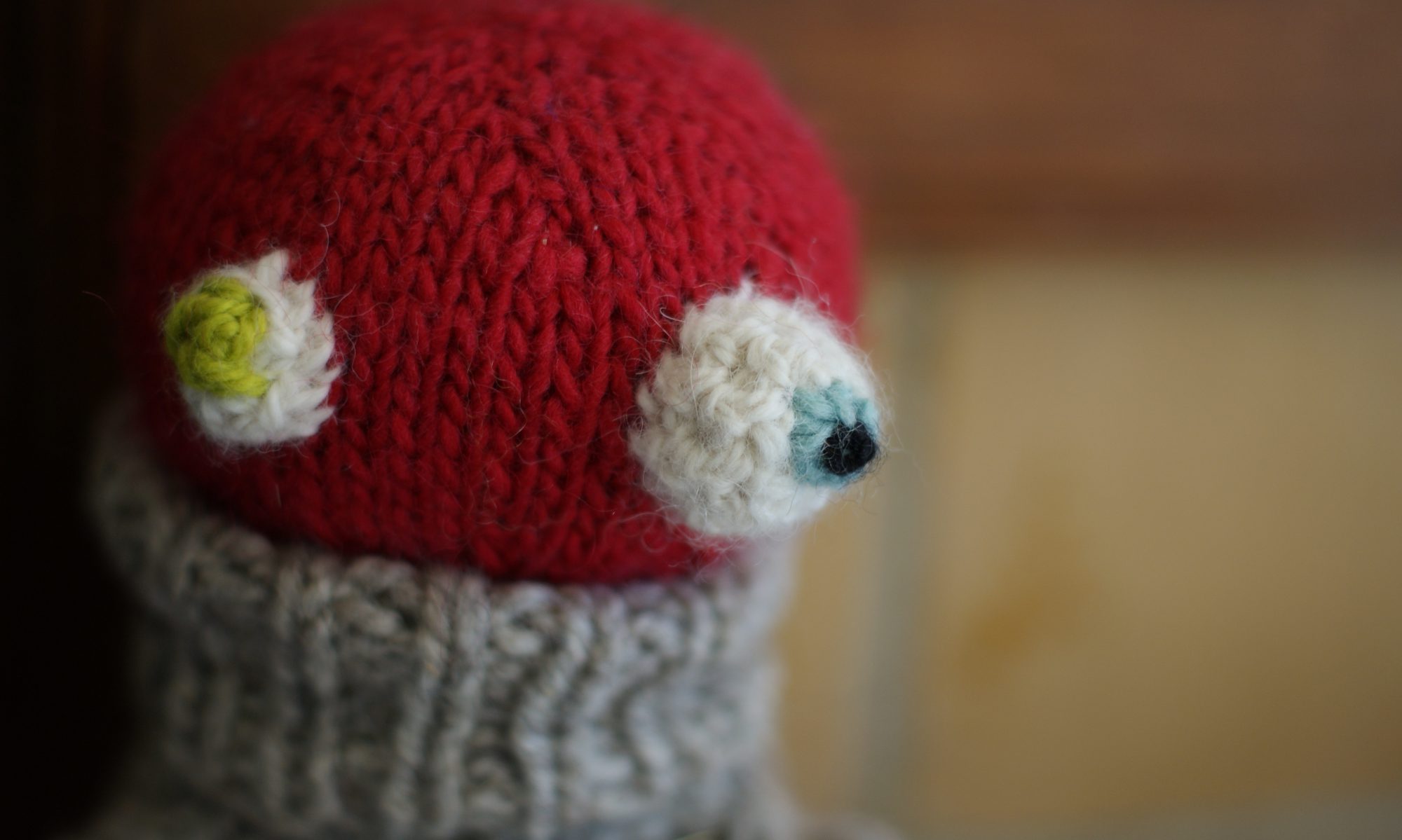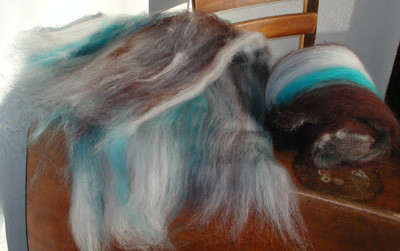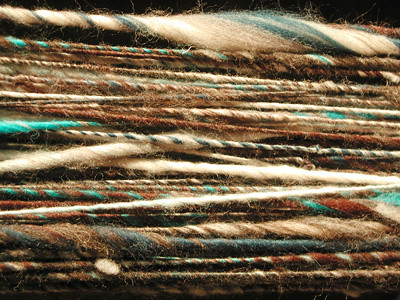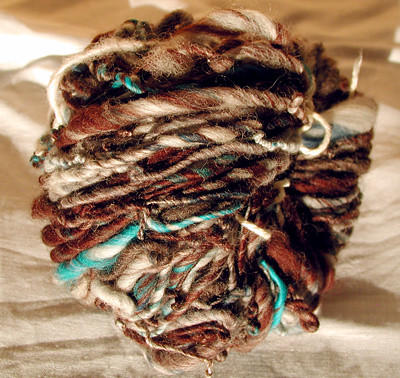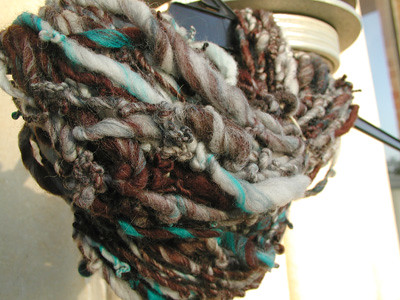Um, this isn’t interesting to anyone but me…
After a week of picking and teasing and dyeing, I finally sent off 6 fleeces worth of dyed-in-the-grease wool to the mill for processing into 3 batches of roving: Fire (A), Sea (B), and Goth (C). Maybe I’ll give them more fanciful names when they get back, but that’s how they struck me as raw wool.
It was a lot a lot of work, and I have no idea how the results will be. If I had it to do over, I’d probably chuck the Suffolk & Dorset altogether, but I’m not quitter (or maybe I felt like I deserved the punishment after being so stupid as to buy raw wool on ebay). It’s supposed to get to me at Jason’s before the Renegade Craft Fair, so if it’s lovely, I can sell it there. And if it’s unlovely, I’ll at least have a little fiber to play with. I was going to ask Santa for a travel wheel for my birthday, but I can’t decide which one (and most are to expensive to ask for), so maybe I’ll just break down my regular wheel and bring it.

Now, if you decide to dye your own fleece to make roving, heed my advice: Do not buy fleece on eBay. Everyone warns you, but I didn’t know that until it was too late (and I even went back later and bought more, despite my bad luck–dumb as an onion, sheesh). I realize there are a few reputable sellers, but those ones generally sell off ebay as well, where they’re not invisible. By and large, everything I got on ebay was a mess, and the very best eBay fleece–okay, well, the very best one doesn’t count, because it was pretty nice Targhee (but it was from a farm that sells directly as well, so next time I’ll skip the ebay), so let’s throw out that one and say the next nicest fleece from ebay–was well below the most unremarkable fleece I bought directly from a farmer or rancher. And some of the ones I’ve bought from ranchers were just freaking breathtaking.
 So yes, I bought a bunch of yucky fleeces on eBay in the exciting flush of a new hobby, and my punishment for being so reckless was to have to pick through the fucking rubble. Nothing teaches you a valuable lesson like beating and plucking apart wads of stinky wool and getting coated with a thick grit of pasture crud. But I’m too stubborn to be able to let go and just chuck something cruddy if I’m even a little convinced I might be able to fix it (which explains my last relationship, only that took 8 years instead of a week).
So yes, I bought a bunch of yucky fleeces on eBay in the exciting flush of a new hobby, and my punishment for being so reckless was to have to pick through the fucking rubble. Nothing teaches you a valuable lesson like beating and plucking apart wads of stinky wool and getting coated with a thick grit of pasture crud. But I’m too stubborn to be able to let go and just chuck something cruddy if I’m even a little convinced I might be able to fix it (which explains my last relationship, only that took 8 years instead of a week).
For the base of the first two rovings, I started with two Suffolk fleeces from eBay. Getting them reasonably cleared out would like to have killed me, but I’m hoping the result was, if not a swan, at least a pretty respectable duck. You can’t see all the hay still in the wool, despite my best efforts, but it’s there. (Cross my fingers it flies out in the carding, a pretty good bet, an the rest should drop in spinning.)
 To give you an idea of the waste, I started with 15# total of Suffolk and wound up with just 8 1/2 pounds in the grease. This was a fleece that allegedly had already had the unusable parts removed (I guess big felted crusty mats are technically useable, in some context… soaking up oil spills?) I chucked the really shitty, matted, overly tangled with VM, and super short stuff and spent hours teasing the VM out of the rest. Since half was useless, the price was twice as high per pound–more really, because I paid to ship all that garbage, too. 8 1/2# in the grease means probably 4-5# after it’s clean, and with processing ($5.25/#) and shipping, it won’t be any cheaper than just buying it finished, but it will be my own blood, sweat & tears custom blend.
To give you an idea of the waste, I started with 15# total of Suffolk and wound up with just 8 1/2 pounds in the grease. This was a fleece that allegedly had already had the unusable parts removed (I guess big felted crusty mats are technically useable, in some context… soaking up oil spills?) I chucked the really shitty, matted, overly tangled with VM, and super short stuff and spent hours teasing the VM out of the rest. Since half was useless, the price was twice as high per pound–more really, because I paid to ship all that garbage, too. 8 1/2# in the grease means probably 4-5# after it’s clean, and with processing ($5.25/#) and shipping, it won’t be any cheaper than just buying it finished, but it will be my own blood, sweat & tears custom blend.
Sigh. Live and learn. (I asked the seller to refund half the price since half of it was actual garbage and I’m still eating the shipping, but they said no, because I waited too long to complain, so for once in my life I left negative feedback, even though I know they’ll retaliate. My rating may dip a point, but at least I’ll save another stubborn optimist the work and/or shipping expense.)
 I split the Suffolk into four roughly 2# batches and dyed half of it blues and greens (1 batch dark blue-greens, 1 lighter/brighter blue-greens) and half reds and oranges (1 with lots of orange, 1 mostly true reds). The batch shown on the table, which was about 3′ wide and 2′ high, only weighed 2 1/2 pounds, which means probably only 1 1/2 after washing (and a 5# investment, something I’m trying not to remember). The color on the table is way more washed out than real life (for reference, our floor is dark red concrete in real life), and the color of the same stuff in the bag is way more saturated than in real life. The truth is in between.
I split the Suffolk into four roughly 2# batches and dyed half of it blues and greens (1 batch dark blue-greens, 1 lighter/brighter blue-greens) and half reds and oranges (1 with lots of orange, 1 mostly true reds). The batch shown on the table, which was about 3′ wide and 2′ high, only weighed 2 1/2 pounds, which means probably only 1 1/2 after washing (and a 5# investment, something I’m trying not to remember). The color on the table is way more washed out than real life (for reference, our floor is dark red concrete in real life), and the color of the same stuff in the bag is way more saturated than in real life. The truth is in between.
I also split & dyed a nice Corriedale fleece from Irwin Sheep to blend into each color for a little softness and bright color. The Corriedale really sucked up the dye, so I’m hoping it will retain more after scouring and help turn up the color volume of the finished roving. I think the greasy Suffolk & Dorset might lose a lot of intensity–but stuff always spins up darker than it looks as fiber, so that might be for the best. Those had a little toning, but were more or less primaries. I was going to keep a bunch of samples and scour them, but by the end of it, I just thought: surprise me.
 For the Goth roving, I started with Dorset (also a nightmare of skirting and picking, but the seller was gracious and gave me a partial refund). I dyed it kind of sickly reds, blues, and purples. The idea was a withered garden or a dead bouquet. It’s ugly, but in a sort of pleasing way, with little bursts of surprisingly nice color. There’s way more of the gross red than you see in this picture.
For the Goth roving, I started with Dorset (also a nightmare of skirting and picking, but the seller was gracious and gave me a partial refund). I dyed it kind of sickly reds, blues, and purples. The idea was a withered garden or a dead bouquet. It’s ugly, but in a sort of pleasing way, with little bursts of surprisingly nice color. There’s way more of the gross red than you see in this picture.
Then I split and dyed an eBay Cheviot (not bad) and a nice Cheviot from Hill Shepherd for toning all 3–dark auburns and oranges for the Fire, rich sea blues and greens for Sea, and navy blues for the Goth. I picked the Cheviot to add strength and luster. It looked really, really pretty dyed, the pictures don’t do it justice. The color was rich and still kind of ethereal, like brushed mohair. At some point, I’ll get another Cheviot and process and dye it by hand, because it was pretty easy to handle–resisted felting, not too greasy, and a nice length. It’s coarser than what I’d typically go for, but it’s also very strong and lofty.



I’m hoping the Corriedale and Cheviot cut down the loss averages, since they feel way less greasy. All in all, A/Fire started as just a hair under 8# grease wool; B/Sea as just under 8#, and C/Goth as about 4.4#. I’ll report back with pictures & weights when I have the stuff in my hot little hands.
